Travelodge Case Study: Evaluating Business Strategy with SWOT & PESTLE
VerifiedAdded on 2023/06/05
|9
|2031
|383
Case Study
AI Summary
This case study provides an in-depth analysis of Travelodge, a global hospitality chain, focusing on its organizational structure and business environment. It evaluates the hierarchical organizational structure, highlighting its advantages and disadvantages in the context of Travelodge's operations. The study uses SWOT analysis to assess the company's internal strengths and weaknesses, as well as external opportunities and threats, including the impact of the Covid-19 pandemic and increased competition. Furthermore, a PESTLE analysis examines the political, economic, social, technological, legal, and environmental factors affecting Travelodge, covering aspects such as tax rates, economic conditions, social trends, technological advancements, legal compliance, and environmental responsibilities. The report concludes by emphasizing the importance of continuous research and strategic planning for Travelodge to maintain a competitive edge and adapt to the dynamic business environment.
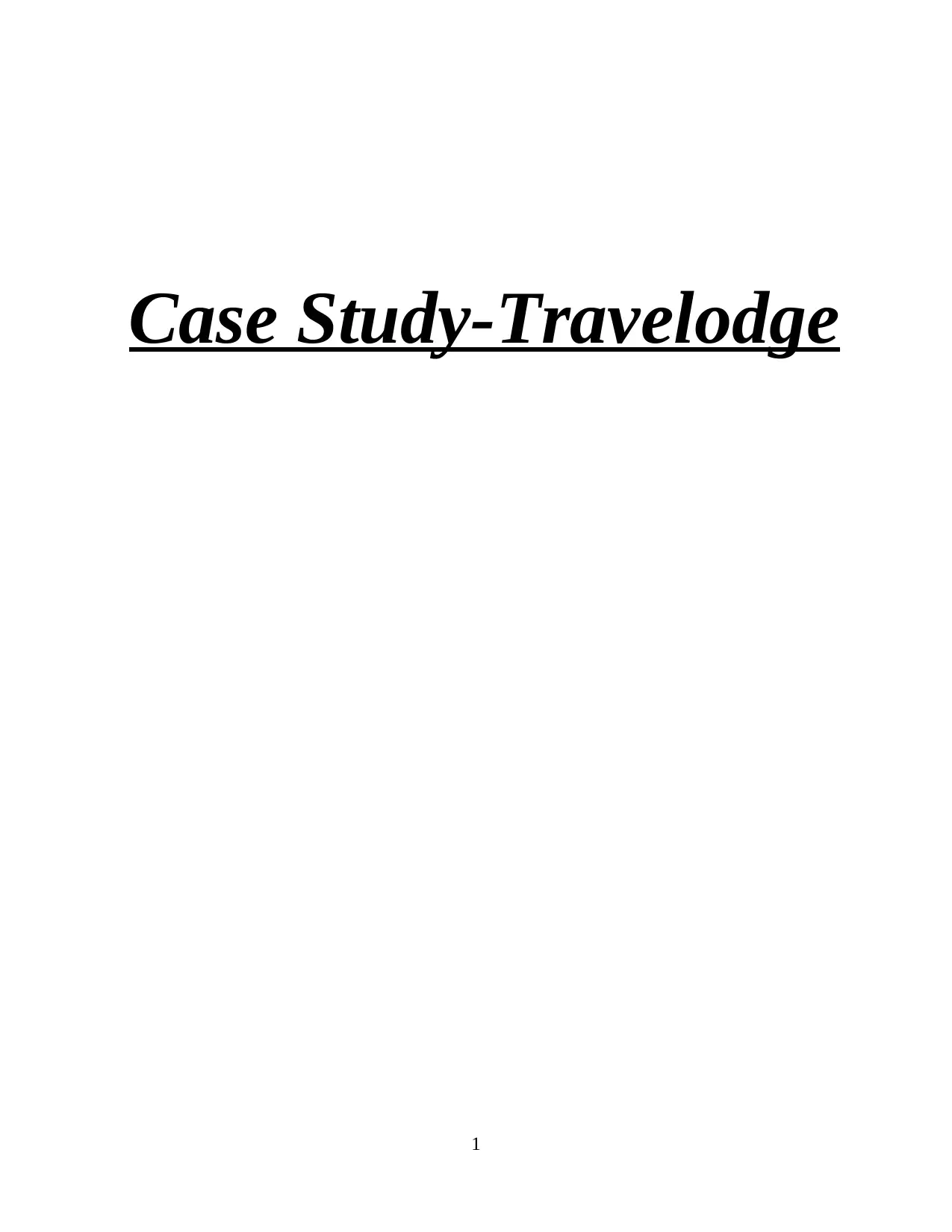
Case Study-Travelodge
1
1
Paraphrase This Document
Need a fresh take? Get an instant paraphrase of this document with our AI Paraphraser

Table of Contents
INTRODUCTION...........................................................................................................................3
MAIN BODY...................................................................................................................................3
Organisational structure..........................................................................................................3
Business environment.............................................................................................................4
SWOT Analysis......................................................................................................................5
PESTLE Analysis...................................................................................................................6
CONCLUSION................................................................................................................................8
REFERENCES:...............................................................................................................................9
Books and Journals.................................................................................................................9
2
INTRODUCTION...........................................................................................................................3
MAIN BODY...................................................................................................................................3
Organisational structure..........................................................................................................3
Business environment.............................................................................................................4
SWOT Analysis......................................................................................................................5
PESTLE Analysis...................................................................................................................6
CONCLUSION................................................................................................................................8
REFERENCES:...............................................................................................................................9
Books and Journals.................................................................................................................9
2
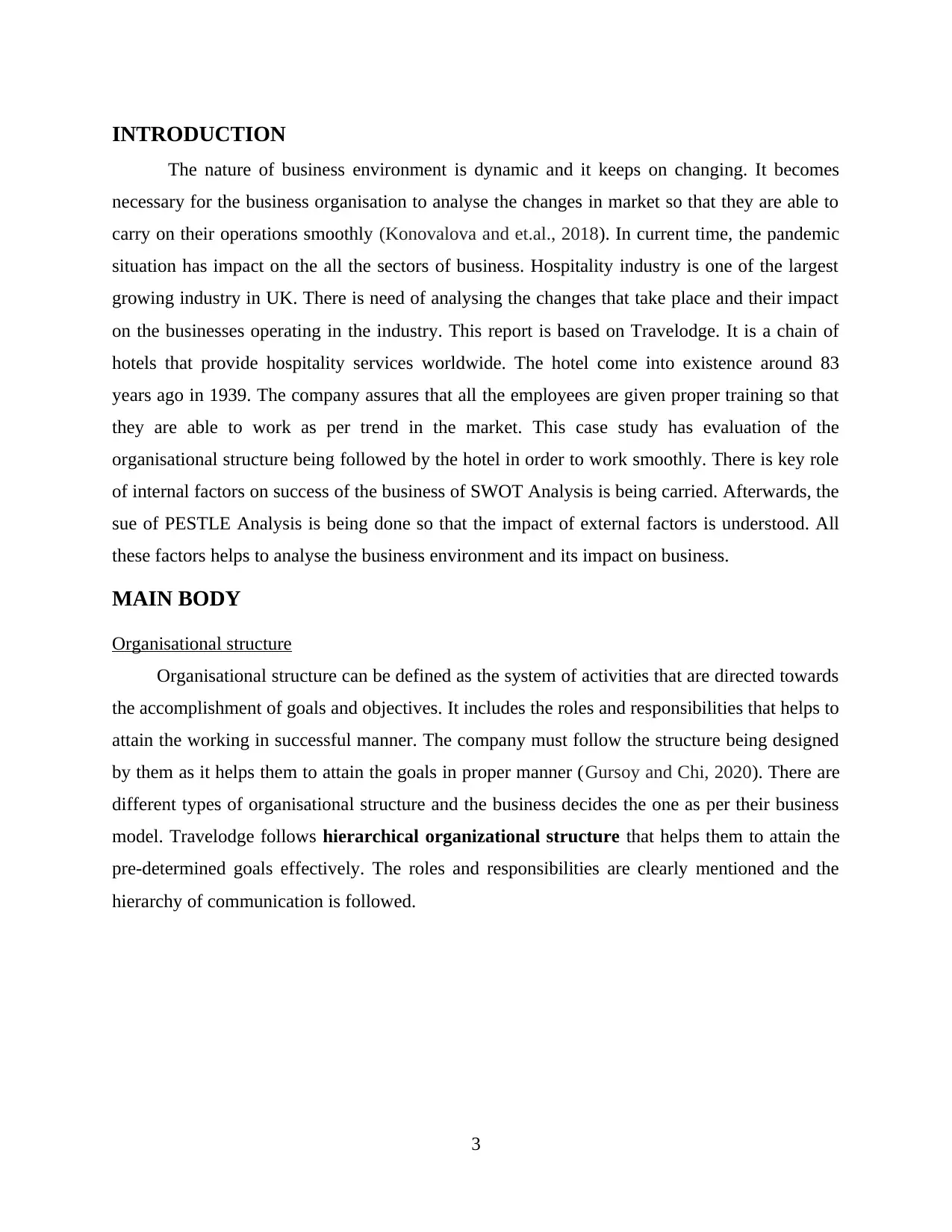
INTRODUCTION
The nature of business environment is dynamic and it keeps on changing. It becomes
necessary for the business organisation to analyse the changes in market so that they are able to
carry on their operations smoothly (Konovalova and et.al., 2018). In current time, the pandemic
situation has impact on the all the sectors of business. Hospitality industry is one of the largest
growing industry in UK. There is need of analysing the changes that take place and their impact
on the businesses operating in the industry. This report is based on Travelodge. It is a chain of
hotels that provide hospitality services worldwide. The hotel come into existence around 83
years ago in 1939. The company assures that all the employees are given proper training so that
they are able to work as per trend in the market. This case study has evaluation of the
organisational structure being followed by the hotel in order to work smoothly. There is key role
of internal factors on success of the business of SWOT Analysis is being carried. Afterwards, the
sue of PESTLE Analysis is being done so that the impact of external factors is understood. All
these factors helps to analyse the business environment and its impact on business.
MAIN BODY
Organisational structure
Organisational structure can be defined as the system of activities that are directed towards
the accomplishment of goals and objectives. It includes the roles and responsibilities that helps to
attain the working in successful manner. The company must follow the structure being designed
by them as it helps them to attain the goals in proper manner (Gursoy and Chi, 2020). There are
different types of organisational structure and the business decides the one as per their business
model. Travelodge follows hierarchical organizational structure that helps them to attain the
pre-determined goals effectively. The roles and responsibilities are clearly mentioned and the
hierarchy of communication is followed.
3
The nature of business environment is dynamic and it keeps on changing. It becomes
necessary for the business organisation to analyse the changes in market so that they are able to
carry on their operations smoothly (Konovalova and et.al., 2018). In current time, the pandemic
situation has impact on the all the sectors of business. Hospitality industry is one of the largest
growing industry in UK. There is need of analysing the changes that take place and their impact
on the businesses operating in the industry. This report is based on Travelodge. It is a chain of
hotels that provide hospitality services worldwide. The hotel come into existence around 83
years ago in 1939. The company assures that all the employees are given proper training so that
they are able to work as per trend in the market. This case study has evaluation of the
organisational structure being followed by the hotel in order to work smoothly. There is key role
of internal factors on success of the business of SWOT Analysis is being carried. Afterwards, the
sue of PESTLE Analysis is being done so that the impact of external factors is understood. All
these factors helps to analyse the business environment and its impact on business.
MAIN BODY
Organisational structure
Organisational structure can be defined as the system of activities that are directed towards
the accomplishment of goals and objectives. It includes the roles and responsibilities that helps to
attain the working in successful manner. The company must follow the structure being designed
by them as it helps them to attain the goals in proper manner (Gursoy and Chi, 2020). There are
different types of organisational structure and the business decides the one as per their business
model. Travelodge follows hierarchical organizational structure that helps them to attain the
pre-determined goals effectively. The roles and responsibilities are clearly mentioned and the
hierarchy of communication is followed.
3
⊘ This is a preview!⊘
Do you want full access?
Subscribe today to unlock all pages.

Trusted by 1+ million students worldwide
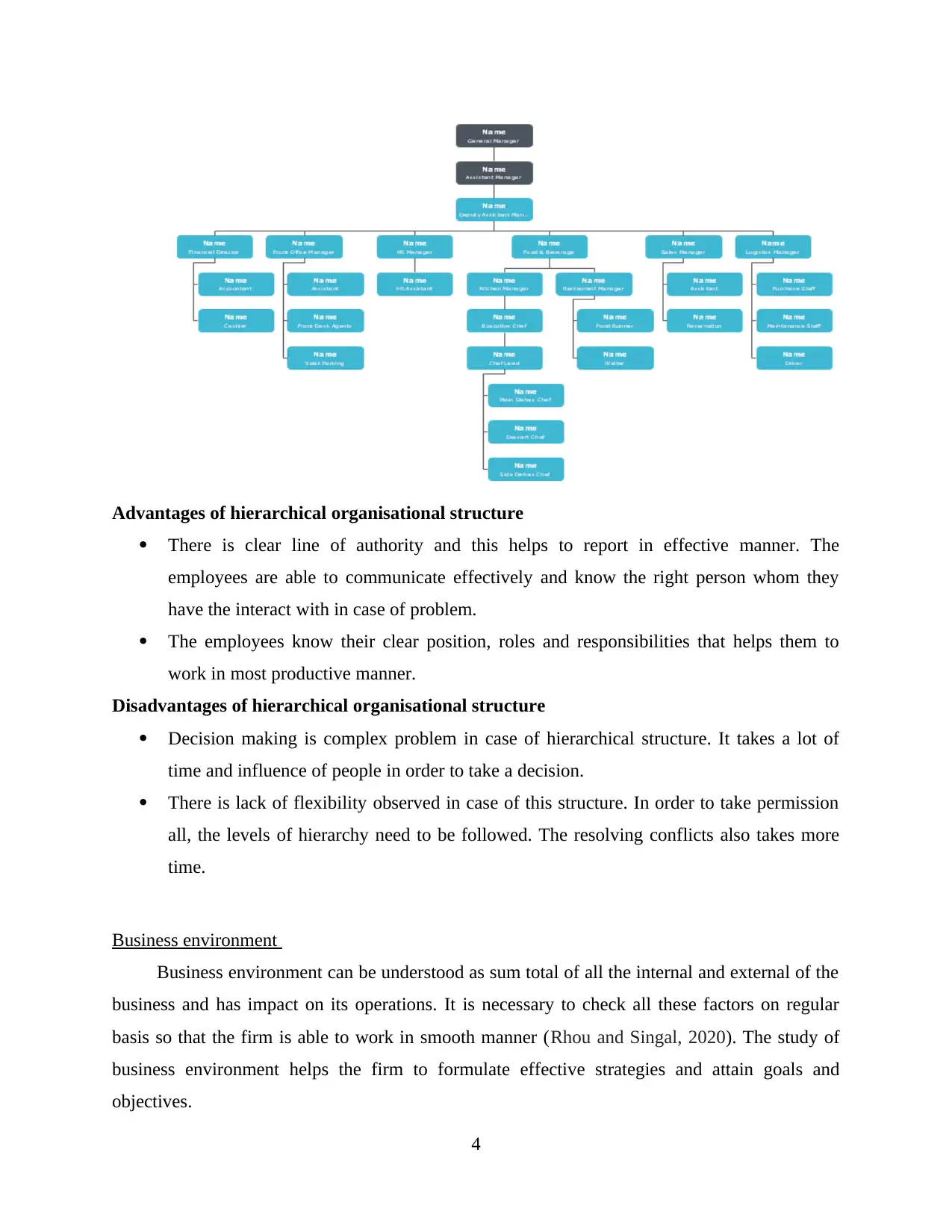
Advantages of hierarchical organisational structure
There is clear line of authority and this helps to report in effective manner. The
employees are able to communicate effectively and know the right person whom they
have the interact with in case of problem.
The employees know their clear position, roles and responsibilities that helps them to
work in most productive manner.
Disadvantages of hierarchical organisational structure
Decision making is complex problem in case of hierarchical structure. It takes a lot of
time and influence of people in order to take a decision.
There is lack of flexibility observed in case of this structure. In order to take permission
all, the levels of hierarchy need to be followed. The resolving conflicts also takes more
time.
Business environment
Business environment can be understood as sum total of all the internal and external of the
business and has impact on its operations. It is necessary to check all these factors on regular
basis so that the firm is able to work in smooth manner (Rhou and Singal, 2020). The study of
business environment helps the firm to formulate effective strategies and attain goals and
objectives.
4
There is clear line of authority and this helps to report in effective manner. The
employees are able to communicate effectively and know the right person whom they
have the interact with in case of problem.
The employees know their clear position, roles and responsibilities that helps them to
work in most productive manner.
Disadvantages of hierarchical organisational structure
Decision making is complex problem in case of hierarchical structure. It takes a lot of
time and influence of people in order to take a decision.
There is lack of flexibility observed in case of this structure. In order to take permission
all, the levels of hierarchy need to be followed. The resolving conflicts also takes more
time.
Business environment
Business environment can be understood as sum total of all the internal and external of the
business and has impact on its operations. It is necessary to check all these factors on regular
basis so that the firm is able to work in smooth manner (Rhou and Singal, 2020). The study of
business environment helps the firm to formulate effective strategies and attain goals and
objectives.
4
Paraphrase This Document
Need a fresh take? Get an instant paraphrase of this document with our AI Paraphraser
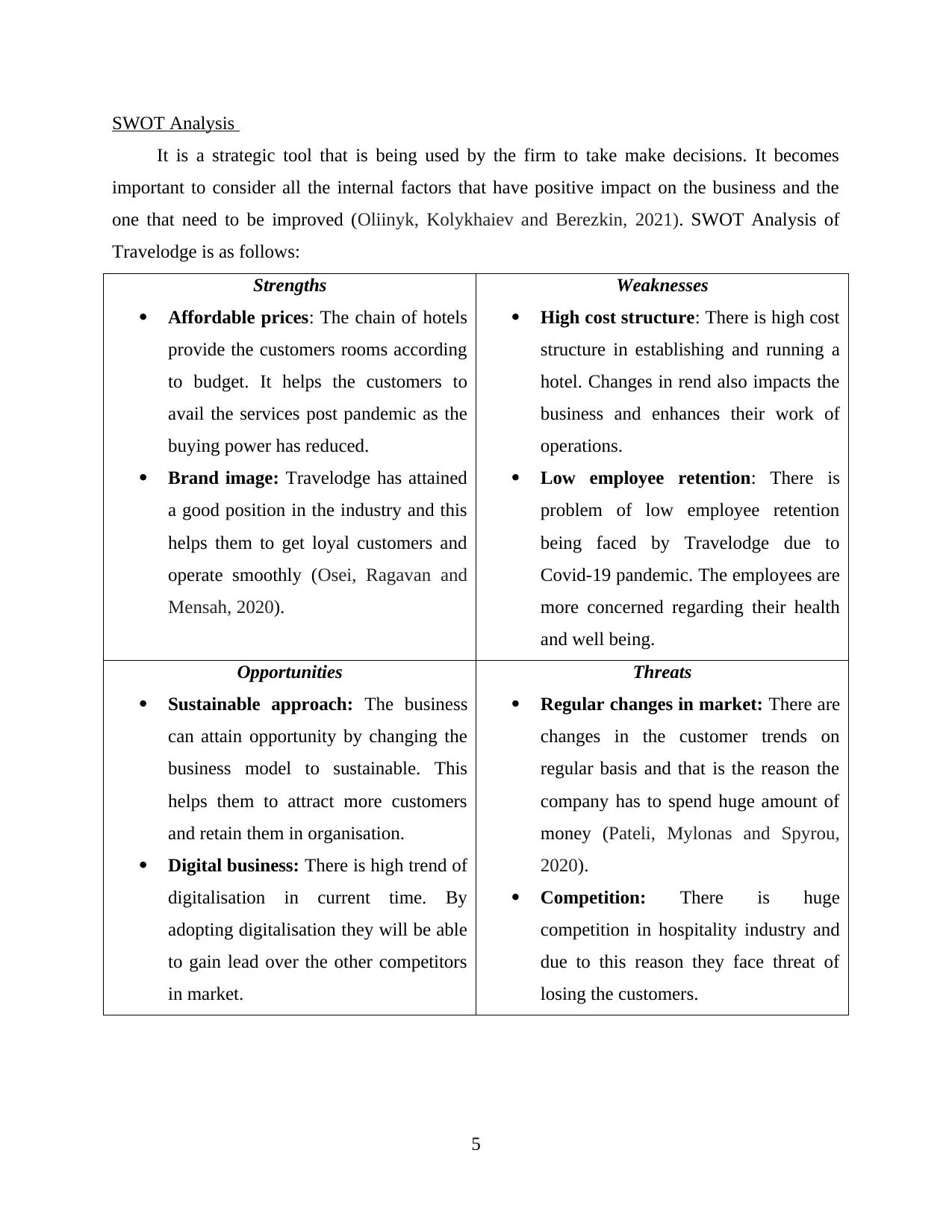
SWOT Analysis
It is a strategic tool that is being used by the firm to take make decisions. It becomes
important to consider all the internal factors that have positive impact on the business and the
one that need to be improved (Oliinyk, Kolykhaiev and Berezkin, 2021). SWOT Analysis of
Travelodge is as follows:
Strengths
Affordable prices: The chain of hotels
provide the customers rooms according
to budget. It helps the customers to
avail the services post pandemic as the
buying power has reduced.
Brand image: Travelodge has attained
a good position in the industry and this
helps them to get loyal customers and
operate smoothly (Osei, Ragavan and
Mensah, 2020).
Weaknesses
High cost structure: There is high cost
structure in establishing and running a
hotel. Changes in rend also impacts the
business and enhances their work of
operations.
Low employee retention: There is
problem of low employee retention
being faced by Travelodge due to
Covid-19 pandemic. The employees are
more concerned regarding their health
and well being.
Opportunities
Sustainable approach: The business
can attain opportunity by changing the
business model to sustainable. This
helps them to attract more customers
and retain them in organisation.
Digital business: There is high trend of
digitalisation in current time. By
adopting digitalisation they will be able
to gain lead over the other competitors
in market.
Threats
Regular changes in market: There are
changes in the customer trends on
regular basis and that is the reason the
company has to spend huge amount of
money (Pateli, Mylonas and Spyrou,
2020).
Competition: There is huge
competition in hospitality industry and
due to this reason they face threat of
losing the customers.
5
It is a strategic tool that is being used by the firm to take make decisions. It becomes
important to consider all the internal factors that have positive impact on the business and the
one that need to be improved (Oliinyk, Kolykhaiev and Berezkin, 2021). SWOT Analysis of
Travelodge is as follows:
Strengths
Affordable prices: The chain of hotels
provide the customers rooms according
to budget. It helps the customers to
avail the services post pandemic as the
buying power has reduced.
Brand image: Travelodge has attained
a good position in the industry and this
helps them to get loyal customers and
operate smoothly (Osei, Ragavan and
Mensah, 2020).
Weaknesses
High cost structure: There is high cost
structure in establishing and running a
hotel. Changes in rend also impacts the
business and enhances their work of
operations.
Low employee retention: There is
problem of low employee retention
being faced by Travelodge due to
Covid-19 pandemic. The employees are
more concerned regarding their health
and well being.
Opportunities
Sustainable approach: The business
can attain opportunity by changing the
business model to sustainable. This
helps them to attract more customers
and retain them in organisation.
Digital business: There is high trend of
digitalisation in current time. By
adopting digitalisation they will be able
to gain lead over the other competitors
in market.
Threats
Regular changes in market: There are
changes in the customer trends on
regular basis and that is the reason the
company has to spend huge amount of
money (Pateli, Mylonas and Spyrou,
2020).
Competition: There is huge
competition in hospitality industry and
due to this reason they face threat of
losing the customers.
5
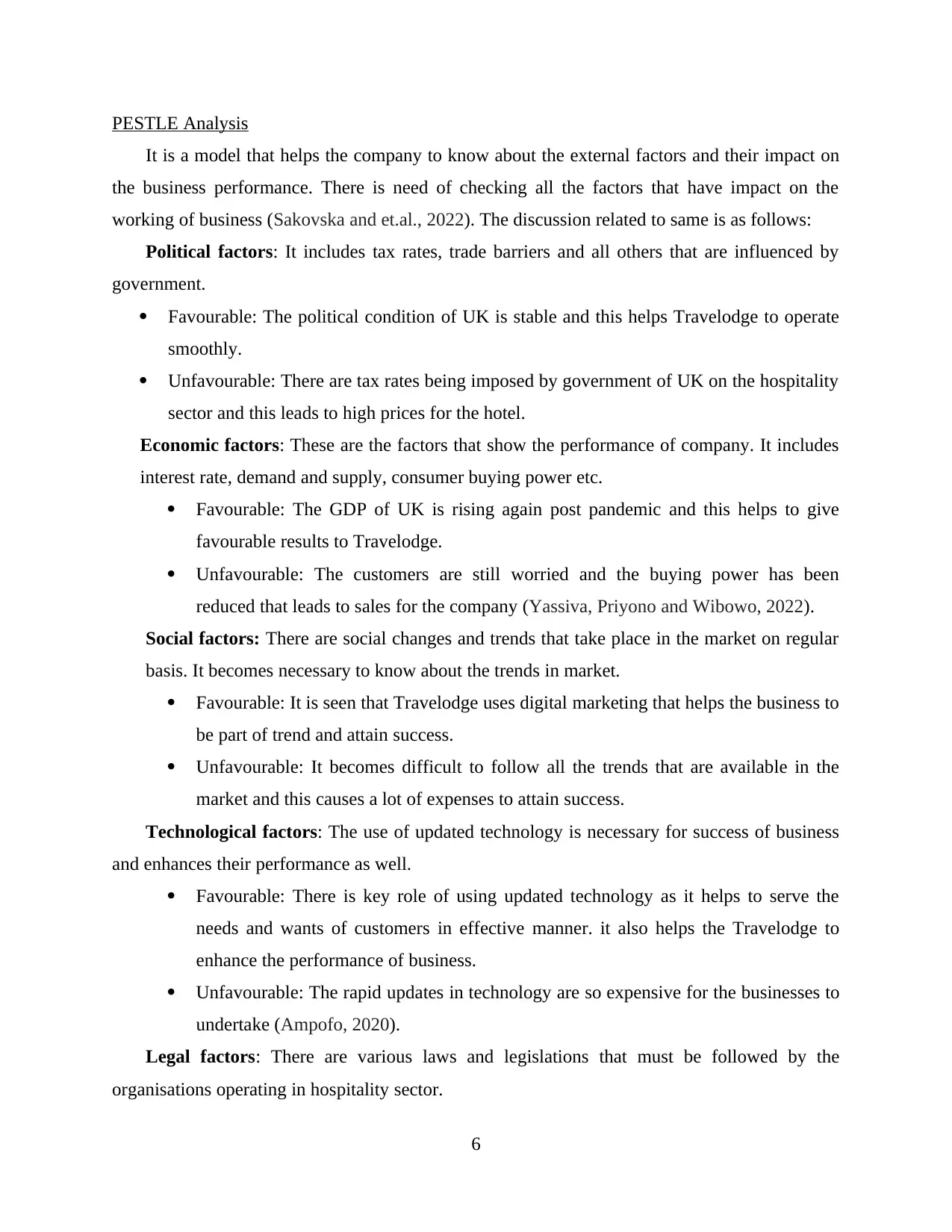
PESTLE Analysis
It is a model that helps the company to know about the external factors and their impact on
the business performance. There is need of checking all the factors that have impact on the
working of business (Sakovska and et.al., 2022). The discussion related to same is as follows:
Political factors: It includes tax rates, trade barriers and all others that are influenced by
government.
Favourable: The political condition of UK is stable and this helps Travelodge to operate
smoothly.
Unfavourable: There are tax rates being imposed by government of UK on the hospitality
sector and this leads to high prices for the hotel.
Economic factors: These are the factors that show the performance of company. It includes
interest rate, demand and supply, consumer buying power etc.
Favourable: The GDP of UK is rising again post pandemic and this helps to give
favourable results to Travelodge.
Unfavourable: The customers are still worried and the buying power has been
reduced that leads to sales for the company (Yassiva, Priyono and Wibowo, 2022).
Social factors: There are social changes and trends that take place in the market on regular
basis. It becomes necessary to know about the trends in market.
Favourable: It is seen that Travelodge uses digital marketing that helps the business to
be part of trend and attain success.
Unfavourable: It becomes difficult to follow all the trends that are available in the
market and this causes a lot of expenses to attain success.
Technological factors: The use of updated technology is necessary for success of business
and enhances their performance as well.
Favourable: There is key role of using updated technology as it helps to serve the
needs and wants of customers in effective manner. it also helps the Travelodge to
enhance the performance of business.
Unfavourable: The rapid updates in technology are so expensive for the businesses to
undertake (Ampofo, 2020).
Legal factors: There are various laws and legislations that must be followed by the
organisations operating in hospitality sector.
6
It is a model that helps the company to know about the external factors and their impact on
the business performance. There is need of checking all the factors that have impact on the
working of business (Sakovska and et.al., 2022). The discussion related to same is as follows:
Political factors: It includes tax rates, trade barriers and all others that are influenced by
government.
Favourable: The political condition of UK is stable and this helps Travelodge to operate
smoothly.
Unfavourable: There are tax rates being imposed by government of UK on the hospitality
sector and this leads to high prices for the hotel.
Economic factors: These are the factors that show the performance of company. It includes
interest rate, demand and supply, consumer buying power etc.
Favourable: The GDP of UK is rising again post pandemic and this helps to give
favourable results to Travelodge.
Unfavourable: The customers are still worried and the buying power has been
reduced that leads to sales for the company (Yassiva, Priyono and Wibowo, 2022).
Social factors: There are social changes and trends that take place in the market on regular
basis. It becomes necessary to know about the trends in market.
Favourable: It is seen that Travelodge uses digital marketing that helps the business to
be part of trend and attain success.
Unfavourable: It becomes difficult to follow all the trends that are available in the
market and this causes a lot of expenses to attain success.
Technological factors: The use of updated technology is necessary for success of business
and enhances their performance as well.
Favourable: There is key role of using updated technology as it helps to serve the
needs and wants of customers in effective manner. it also helps the Travelodge to
enhance the performance of business.
Unfavourable: The rapid updates in technology are so expensive for the businesses to
undertake (Ampofo, 2020).
Legal factors: There are various laws and legislations that must be followed by the
organisations operating in hospitality sector.
6
⊘ This is a preview!⊘
Do you want full access?
Subscribe today to unlock all pages.

Trusted by 1+ million students worldwide
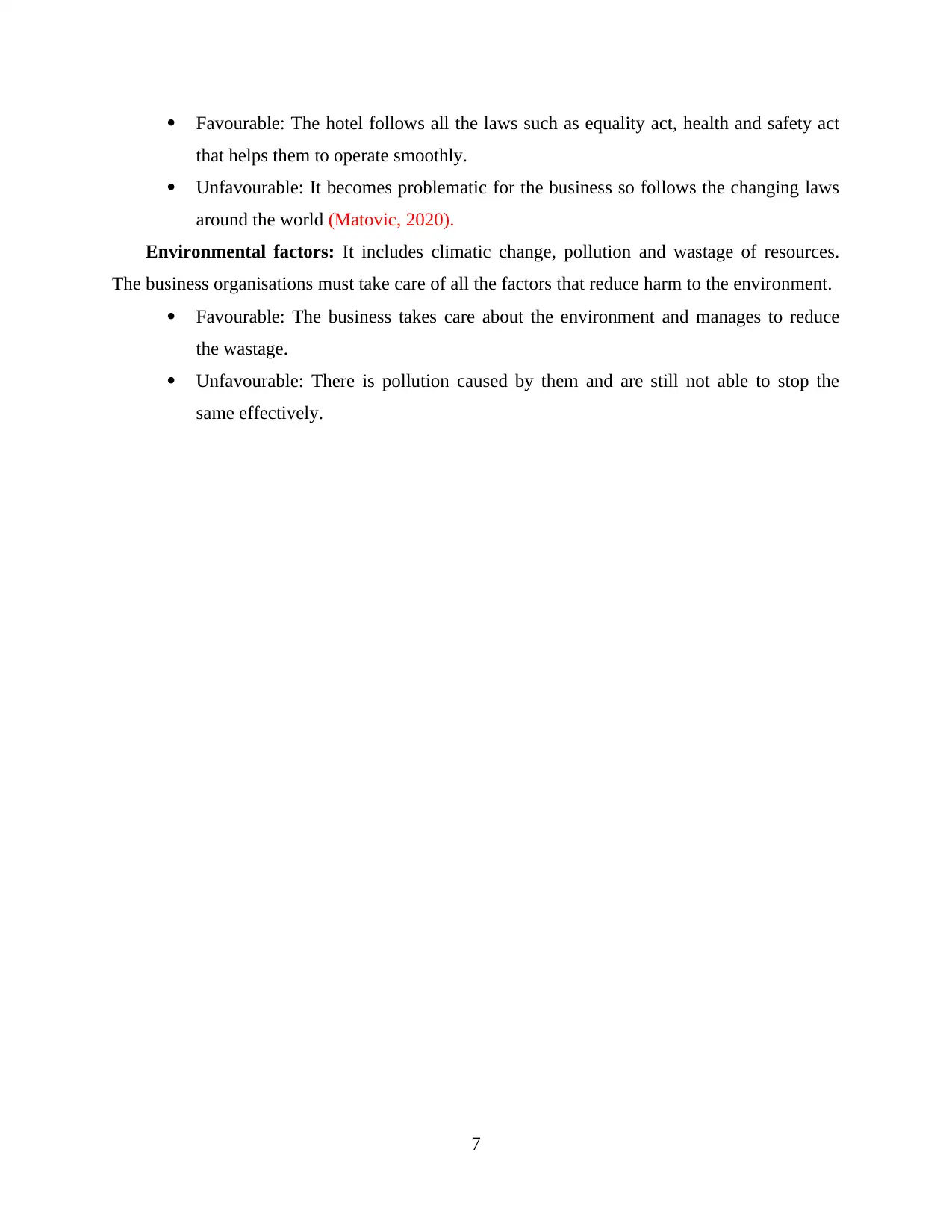
Favourable: The hotel follows all the laws such as equality act, health and safety act
that helps them to operate smoothly.
Unfavourable: It becomes problematic for the business so follows the changing laws
around the world (Matovic, 2020).
Environmental factors: It includes climatic change, pollution and wastage of resources.
The business organisations must take care of all the factors that reduce harm to the environment.
Favourable: The business takes care about the environment and manages to reduce
the wastage.
Unfavourable: There is pollution caused by them and are still not able to stop the
same effectively.
7
that helps them to operate smoothly.
Unfavourable: It becomes problematic for the business so follows the changing laws
around the world (Matovic, 2020).
Environmental factors: It includes climatic change, pollution and wastage of resources.
The business organisations must take care of all the factors that reduce harm to the environment.
Favourable: The business takes care about the environment and manages to reduce
the wastage.
Unfavourable: There is pollution caused by them and are still not able to stop the
same effectively.
7
Paraphrase This Document
Need a fresh take? Get an instant paraphrase of this document with our AI Paraphraser
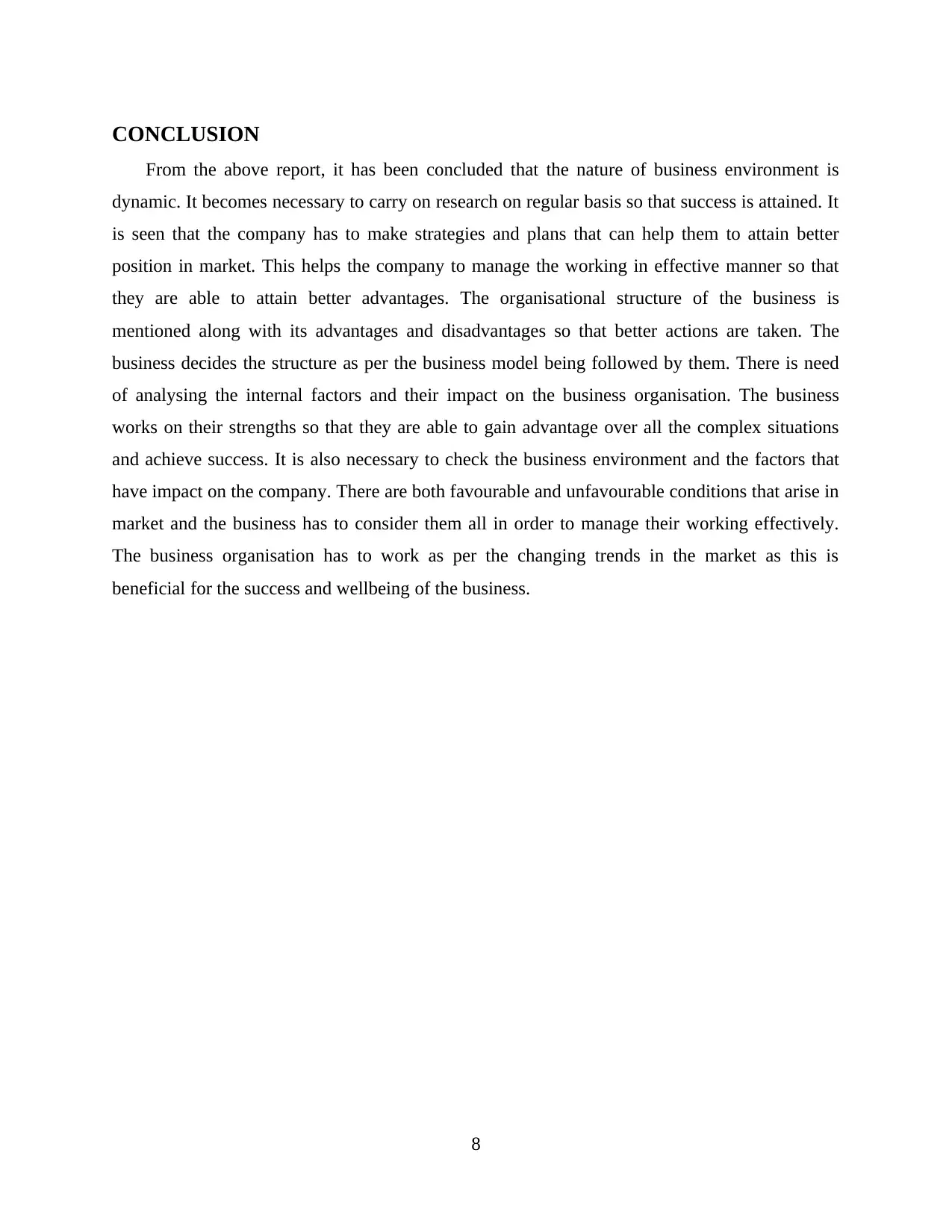
CONCLUSION
From the above report, it has been concluded that the nature of business environment is
dynamic. It becomes necessary to carry on research on regular basis so that success is attained. It
is seen that the company has to make strategies and plans that can help them to attain better
position in market. This helps the company to manage the working in effective manner so that
they are able to attain better advantages. The organisational structure of the business is
mentioned along with its advantages and disadvantages so that better actions are taken. The
business decides the structure as per the business model being followed by them. There is need
of analysing the internal factors and their impact on the business organisation. The business
works on their strengths so that they are able to gain advantage over all the complex situations
and achieve success. It is also necessary to check the business environment and the factors that
have impact on the company. There are both favourable and unfavourable conditions that arise in
market and the business has to consider them all in order to manage their working effectively.
The business organisation has to work as per the changing trends in the market as this is
beneficial for the success and wellbeing of the business.
8
From the above report, it has been concluded that the nature of business environment is
dynamic. It becomes necessary to carry on research on regular basis so that success is attained. It
is seen that the company has to make strategies and plans that can help them to attain better
position in market. This helps the company to manage the working in effective manner so that
they are able to attain better advantages. The organisational structure of the business is
mentioned along with its advantages and disadvantages so that better actions are taken. The
business decides the structure as per the business model being followed by them. There is need
of analysing the internal factors and their impact on the business organisation. The business
works on their strengths so that they are able to gain advantage over all the complex situations
and achieve success. It is also necessary to check the business environment and the factors that
have impact on the company. There are both favourable and unfavourable conditions that arise in
market and the business has to consider them all in order to manage their working effectively.
The business organisation has to work as per the changing trends in the market as this is
beneficial for the success and wellbeing of the business.
8
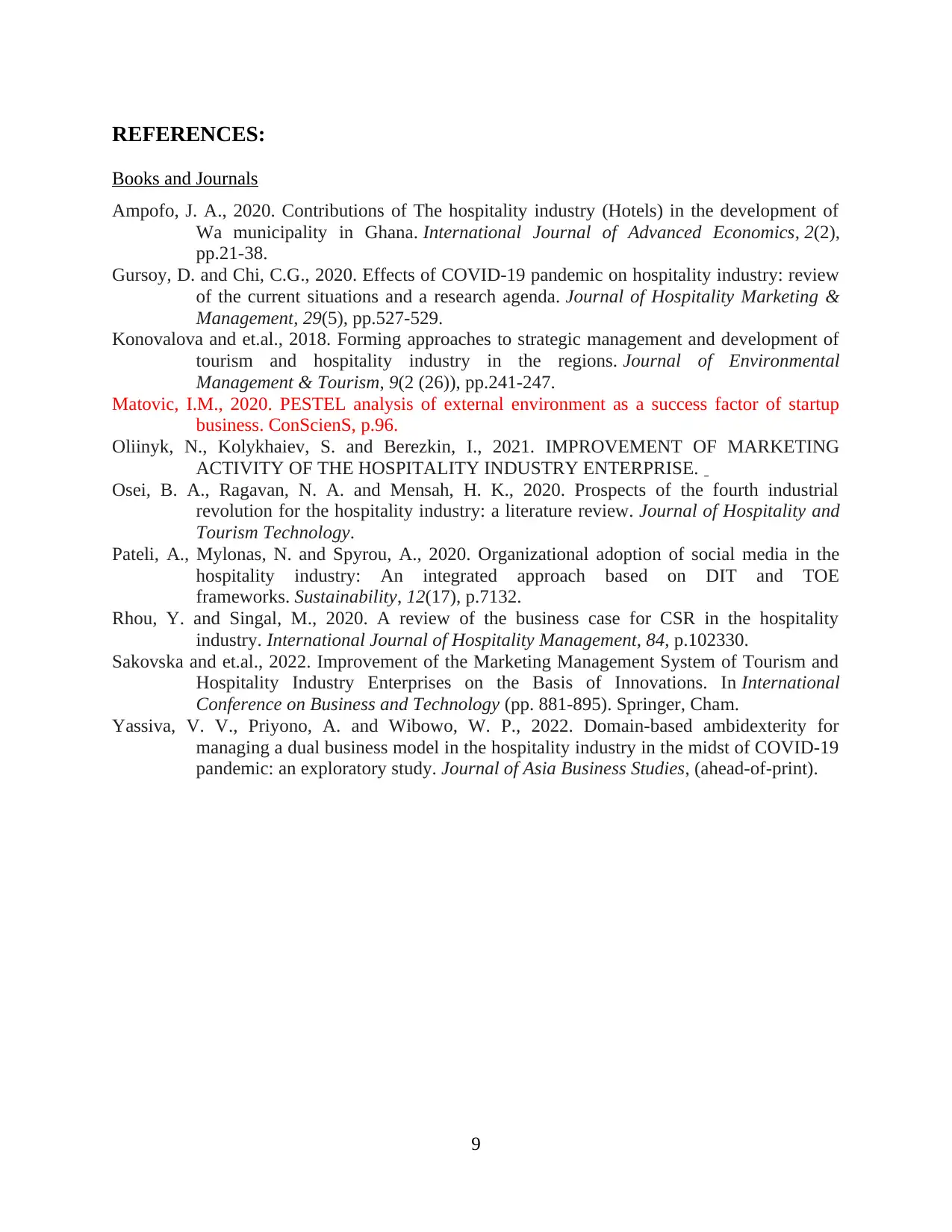
REFERENCES:
Books and Journals
Ampofo, J. A., 2020. Contributions of The hospitality industry (Hotels) in the development of
Wa municipality in Ghana. International Journal of Advanced Economics, 2(2),
pp.21-38.
Gursoy, D. and Chi, C.G., 2020. Effects of COVID-19 pandemic on hospitality industry: review
of the current situations and a research agenda. Journal of Hospitality Marketing &
Management, 29(5), pp.527-529.
Konovalova and et.al., 2018. Forming approaches to strategic management and development of
tourism and hospitality industry in the regions. Journal of Environmental
Management & Tourism, 9(2 (26)), pp.241-247.
Matovic, I.M., 2020. PESTEL analysis of external environment as a success factor of startup
business. ConScienS, p.96.
Oliinyk, N., Kolykhaiev, S. and Berezkin, I., 2021. IMPROVEMENT OF MARKETING
ACTIVITY OF THE HOSPITALITY INDUSTRY ENTERPRISE.
Osei, B. A., Ragavan, N. A. and Mensah, H. K., 2020. Prospects of the fourth industrial
revolution for the hospitality industry: a literature review. Journal of Hospitality and
Tourism Technology.
Pateli, A., Mylonas, N. and Spyrou, A., 2020. Organizational adoption of social media in the
hospitality industry: An integrated approach based on DIT and TOE
frameworks. Sustainability, 12(17), p.7132.
Rhou, Y. and Singal, M., 2020. A review of the business case for CSR in the hospitality
industry. International Journal of Hospitality Management, 84, p.102330.
Sakovska and et.al., 2022. Improvement of the Marketing Management System of Tourism and
Hospitality Industry Enterprises on the Basis of Innovations. In International
Conference on Business and Technology (pp. 881-895). Springer, Cham.
Yassiva, V. V., Priyono, A. and Wibowo, W. P., 2022. Domain-based ambidexterity for
managing a dual business model in the hospitality industry in the midst of COVID-19
pandemic: an exploratory study. Journal of Asia Business Studies, (ahead-of-print).
9
Books and Journals
Ampofo, J. A., 2020. Contributions of The hospitality industry (Hotels) in the development of
Wa municipality in Ghana. International Journal of Advanced Economics, 2(2),
pp.21-38.
Gursoy, D. and Chi, C.G., 2020. Effects of COVID-19 pandemic on hospitality industry: review
of the current situations and a research agenda. Journal of Hospitality Marketing &
Management, 29(5), pp.527-529.
Konovalova and et.al., 2018. Forming approaches to strategic management and development of
tourism and hospitality industry in the regions. Journal of Environmental
Management & Tourism, 9(2 (26)), pp.241-247.
Matovic, I.M., 2020. PESTEL analysis of external environment as a success factor of startup
business. ConScienS, p.96.
Oliinyk, N., Kolykhaiev, S. and Berezkin, I., 2021. IMPROVEMENT OF MARKETING
ACTIVITY OF THE HOSPITALITY INDUSTRY ENTERPRISE.
Osei, B. A., Ragavan, N. A. and Mensah, H. K., 2020. Prospects of the fourth industrial
revolution for the hospitality industry: a literature review. Journal of Hospitality and
Tourism Technology.
Pateli, A., Mylonas, N. and Spyrou, A., 2020. Organizational adoption of social media in the
hospitality industry: An integrated approach based on DIT and TOE
frameworks. Sustainability, 12(17), p.7132.
Rhou, Y. and Singal, M., 2020. A review of the business case for CSR in the hospitality
industry. International Journal of Hospitality Management, 84, p.102330.
Sakovska and et.al., 2022. Improvement of the Marketing Management System of Tourism and
Hospitality Industry Enterprises on the Basis of Innovations. In International
Conference on Business and Technology (pp. 881-895). Springer, Cham.
Yassiva, V. V., Priyono, A. and Wibowo, W. P., 2022. Domain-based ambidexterity for
managing a dual business model in the hospitality industry in the midst of COVID-19
pandemic: an exploratory study. Journal of Asia Business Studies, (ahead-of-print).
9
⊘ This is a preview!⊘
Do you want full access?
Subscribe today to unlock all pages.

Trusted by 1+ million students worldwide
1 out of 9
Related Documents
Your All-in-One AI-Powered Toolkit for Academic Success.
+13062052269
info@desklib.com
Available 24*7 on WhatsApp / Email
![[object Object]](/_next/static/media/star-bottom.7253800d.svg)
Unlock your academic potential
Copyright © 2020–2025 A2Z Services. All Rights Reserved. Developed and managed by ZUCOL.





